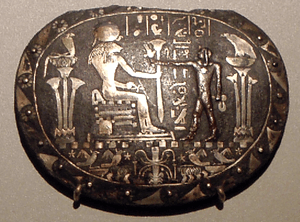Menat

Menat (ancient Egyptian mnj.t) was a name used for the goddess Hathor.[1] With a slightly different hieroglyphic spelling,[2] it referred to an ancient Egyptian artifact which, like the sistrum, was closely connected with the goddess Hathor.[3] It was held in the hand by its counterpoise and used as a rattle by Hathor's priestesses.[4] Often it was worn as a protective amulet, even by Apis bulls, the sons of Hathor.[5]
The menat comprised a plate termed an aegis (Greek for "shield"), worn on the chest, to which strands of beaded strings were attached. The other ends of the strings were tied to a counterweight which dangled on the wearer's back.[6] The aegis was often made of faience, but other materials as varied as leather and bronze were also used.[7] It was often inscribed or bore depictions of deities associated with Hathor, such as the one of Sekhmet displayed to the right.
The necklace was meant to ensure good luck and fortune and to protect against evil spirits. It was also worn for protection in the afterlife and is often found buried with the dead, given as a grave gift since Ramesside times (the Nineteenth and Twentieth Dynasties that comprise the last two-thirds of the period known as the New Kingdom).[8] Worn by women, it was expected to foster fruitfulness and good health, while among men it signified virility.[9]
Notes
- ↑ Ermann & Grapow, op. cit., 2, 76, 4.
- ↑ Ermann & Grapow, op. cit., 2, 75.18-76.3.
- ↑ Armour, op.cit., p. 91.
- ↑ Hart, op. cit., p. 65.
- ↑ Van der Toorn et al., op.cit., p. 70.
- ↑ Bianchi, op. cit., p. 202.
- ↑ Petrie Museum Collection - search for menat
- ↑ Lurker, op. cit., p. 132.
- ↑ Doniger, op. cit., p. 709.
References
- Robert A. Armour, Gods and Myths of Ancient Egypt, American Univ. in Cairo Press 2001
- George Hart, The Routledge Dictionary Of Egyptian Gods And Goddesses, Routledge 2005
- Manfres Lurker, Lexikon der Götter und Symbole der alten Ägypter, Scherz 1974
- Robert Steven Bianchi, Daily Life of the Nubians, Greenwood Press 2004
- Wendy Doniger, Merriam-Webster's Encyclopedia of World Religions, Merriam-Webster 1999
- Karel van der Toorn, Pieter Willem van der Horst, Bob Becking, Wm. B. Eerdmans, Dictionary of Deities and Demons in the Bible, Wm. B. Eerdmans Publishing 1999
- Erman, Johann Peter Adolf, and Hermann Grapow, eds. 1926–1953. Wörterbuch der aegyptischen Sprache im Auftrage der deutschen Akademien. 6 vols. Leipzig: J. C. Hinrichs’schen Buchhandlungen. (Reprinted Berlin: Akademie-Verlag GmbH, 1971).
External links
![]() Media related to Menat-necklace and counterpoise at Wikimedia Commons
Media related to Menat-necklace and counterpoise at Wikimedia Commons